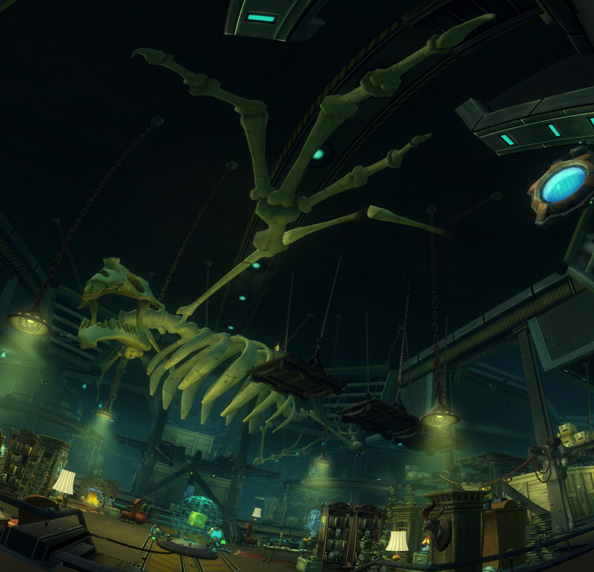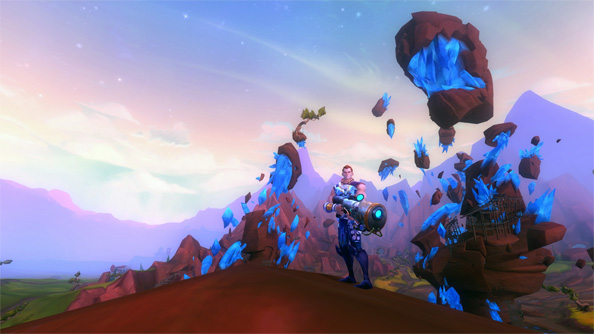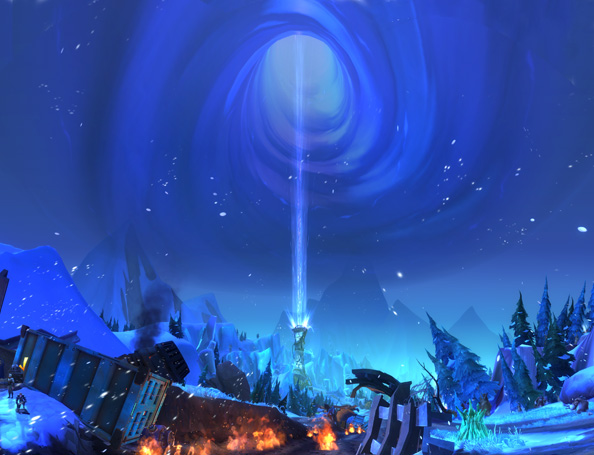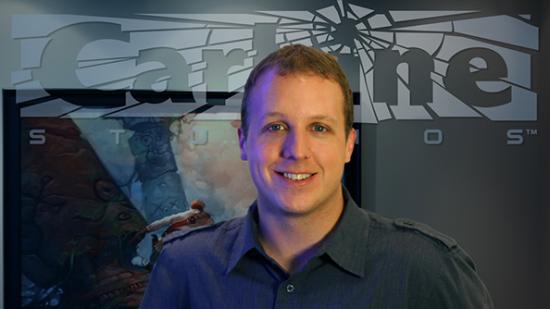Matt Mocarski is WildStar’s creative director, which is a fairly important job to have. But he’s also the MMO’s art director, which presumably means he’s in charge of overseeing all the drawing and the colouring in. His holding both positions at Carbine goes some way towards explaining how WildStar got so lovely looking, with a distinct visual language that lavishes its indoor and outdoor environments in meaningful detail and a beautifully understated comic book aesthetic, which I wouldn’t shut up about in my hands on WildStar beta preview yesterday.
I spoke with Matt Mocarski about his job at Carbine, where he came from, how he broke into the industry and how years upon years of experience informed his artwork on WildStar.
PCGamesN: What’s your background, how did you get into the industry?
Matt Mocarski: So I’ve always been an artist, ever since I was a little kid, and when I was a teenager I decided I wanted to be a comic book artist more than anything. I didn’t have any kind of formal training or anything like that, I just sat in my basement and would draw comic books.
Turns out I wasn’t good enough, obviously, so I decided to go to school and instead of focusing on illustration, I knew that computers were the next big thing, and thought I’d become a special effects guy, because Terminator 2 and Jurassic Park had just come out and I was like “this is where the future is going, there’s going to be a lot of work.”
In school I studied Computer Animation, and I really fell in love with animated films; I think Toy Story came out while I was in school, and it was just amazing, you know? It just started the whole boom of 3D animated films. I still loved the 2D stuff as well – I actually wanted to be a 2D animator while the industry was dying! (Laughs)
So I got out of school and went to the television industry, working as a storyboard artist on animated television shows, and I was doing that for a few years and having a lot of fun doing it, but it was very much like this hardcore contract work where you have to find your next job and you have to worry about that. And all my friends graduated and went into games.
PCGN: Were they having more fun?
MM: Oh yeah, they were having a lot more fun! And I moved in with a buddy of mine who was in games and I just started hanging out at the studio. I’d do contract work at the studio, and I’d just draw what everyone else was doing, and we’d go out and play LAN games together, Quake 3 and Age of Empires and stuff like that. I just kinda got all buddy-buddy with everybody.
Then a job came up and they were all like “Hey, do you think you’d like to do this?” and I was like “sure, but I don’t know if I can!” I hadn’t done 3D for a while so I took a test and I got in. The first game I worked on was Soul Reaver 2.

PCGN: So were you doing 3D models for those guys?
MM: I was primarily a texture artist. I was doing some concept work because the teams were really small back then. You had to wear a lot of hats, we didn’t have a character artist, it was just our animators that made the characters and so there are texture artists and environment artists… we did all the lighting too. So it was just kind of “do whatever you can”, you know? There was less of a defined role like you see in today’s development.
So I worked on that and then I applied at Blizzard and Blizzard hired me. I was on the original WoW team for like, four years, which was a great experience. I rose through the ranks and by the end I was a senior artist on WoW. I still focused primarily on texture and lighting, but I did a lot of modelling myself – I was one of the guys who… me and this other guy, we made most of the cities for the game, like Stormwind and Ogrimarr and all of that stuff, a lot of the dungeons too, and that was a lot of fun.
Now Carbine was started before I left Blizzard, a bunch of guys from the WoW team had started the company, and a few months later I decided to go and work for Ready at Dawn Studios, which worked on Daxter. So I got a chance to work on the PSP and work on Daxter. Ready at Dawn was kinda co-started by a couple of Blizzard guys, so they all knew me and they convinced me to come on board. And it was a great crew and a super-fun project; we built the whole game in basically less than a year, so that was totally different from World of Warcraft where I was on that for like, four years and it had been in development for a few years before that. So yeah, a very different pace from Blizzard where it was all just rapid-fire working for Sony and everything.
And then, one day one of my buddies from Carbine called me up and said “Hey, you want to take a look at what we’re working on? We’re looking for a lead!” And I was really interested, but I was just… “I don’t want to work on another MMO” – I was still a little bit burned out from just working on WoW for so long.
PCGN: So you preferred the kind of work you were doing on Daxter?
MM: So I thought… it was just different, right? And I guess I needed a break. I didn’t realise it at the time. At the time, I thought that I don’t want to work on MMOs. But as I was working on Daxter it was like… there was something I missed, and I missed making worlds, like fully realised worlds. On Daxter we’d start work on a level and they’d be like “what’s this level?” and they’d say “well, it’s a factory” and there was no backstory to the factory – it just existed because it was a platfomer, right?
You just make the most challenging platforming level that you can, it didn’t really make sense, it was just themed as a factory after all the challenge elements got into it. And I started going “Well, I kind of want to show the player… I want to know more about this place” and no-one plays these games for that reason – and it’s true. It was still a great game, but I missed something.
So when the guys at Carbine called me up, I was just like “you know what? I’m going to go and take a look at what they’re working on”, because they’re all talented people and I was super curious.

PCGN: You must have known the people at Carbine pretty well already?
MM: I knew them all. I knew all of them, because I’d worked on all of them with WoW; they were all from WoW. So I went over there, I had lunch, and then they brought me into the studio and they showed me all of this concept art. The art style was very different from what it is today, but it was still very awesome, some of the concepts.
I went home and couldn’t get it out of my head, and I was just like “oh man, I want to make that game so bad!” And I called them up and I was like “okay, I’m in.” – and I started as a lead artist. The first few years of Carbine were pretty rocky; we were a new studio, we didn’t have our IP defined, we weren’t sure what kind of MMO we were going to make.
But it was all the headaches of not only a new IP but a new startup. No-one had ever done it before and there were a lot of challenges that a lot of us weren’t prepared for. And we had to let… some people left, some people had to be let go, some people were in roles that they weren’t experienced in, and things weren’t going so well, we weren’t sure what was going to happen.
And then we just… we kind of just got through the storm. I got promoted to Art Director and some of the other guys got promoted into different positions and we started back filling some of the other roles, and that really set us down the path of where we are today. Like with the art style, it went through two iterations before we got to here, and what it came down to was, what is the team passionate about? What is it… because before there was a lot of in-fighting, about “it should be this” or “it should be that”. Once we started honing in on what people liked we evolved the style from that. And then everybody was happy, it was just really great and everybody got really passionate about the project.
PCGN: This was still some years ago, has Carbine been working on WildStar for the entire time?
MM: So let me say this… and I’m being perfectly upfront about this – that the first few years were a total wash. The game that we were going to make, we pretty much scrapped everything. There’s maybe a few elements – I think maybe the Grannock were erased, I think the Oran were erased, but there wasn’t that much there, and it was a little bit more of a fantasy game too. So the art style was different, the gameplay was different.
PCGN: Sounds like tere were a few different WildStars along the way.
MM: We had a few different prototypes, but nothing solid, and all of that stuff got scrapped.
Since that time we did iterate, we did reboot the IP a few times. When we decided to make more of a sci-fi-centric game we had to rewrite the story and everything, and re-do some of the art to make sure it fit and we finally found our focus… I want to say… four years ago? We really got focused and that’s where we really… that’s where everything else stopped and Wildstar began.

PCGN:During your presentation you mentioned that before you could show anyone the game, you were making the MMO that you guys wanted to make. When you spend so long working on this one thing, do you ever look at it and wonder “is this still good? We’ve been looking at it for so long, we don’t know…” almost like you can’t be objective any more?
MM: I think that’s why we ended up doing a lot of restarts on it. Because for some reason we could look at it objectively and we’re like “this is not it.” And we really appreciate NCsoft – they’ve been developing MMOs for a long time, they understand that you have to get it right if you’re going to be successful.
So yeah, sometimes I think that when we were leading up to announcement we had something we liked, but we weren’t sure if anybody else was going to like it at all. We were so nervous about it because it was a new IP, completely, a new art style, and we were like “Is anybody going to like it at GamesCom?”
We announced it and people were just falling in love with it, and we were all “phew! Okay! We’ve got something good here.” I think ever since we’ve announced we’ve been really confident about the game and the IP and there haven’t been doubts. There’s always critiques – you never stop critiquing yourself, and we always try to push things – like I’ve tried to push the art and technology since we’ve been announced and we’re constantly polishing and iterating and all that stuff, but I think in general we know we’re on the right track.
PCGN: Before we finish, the games that you’ve worked on, Soul Reaver, World of Warcraft, Daxter and this… now that you’ve mentioned those games I do see a real design similarity between the three.
MM: Absolutely! Well I can’t take credit for Daxter, because they kinda established that at Naughty Dog with Jak and Daxter, and they’d already pre-established Soul Reaver, but I’d say this: my influences, like I said, are animation and comic books and cartoons and all that stuff, right? I think whatever I do look for a certain thing. So I’m interested in working on a certain type of art style, or a certain type of project, or something that appeals to me as an artist. So I think it’s less of the project conforming to what I like, it’s more I seek out work that I enjoy doing, moreso than the opposite.
But definitely – I have friends from high school that are like “Your game looks like what you used to do in high school!” and I’m like “Does it? Because I don’t see that at all!” – but I think there is a part of me in that, and there’s a part of me in Warcraft and there’s a part of me in Daxter and a part of me in Soul Reaver because, yeah – you know? You’re an artist and you’re the guy that’s expressing that art, you’re making those assets and of course you’re going to see some similarities between all of those, right?
PCGN: Thank you for your time.
